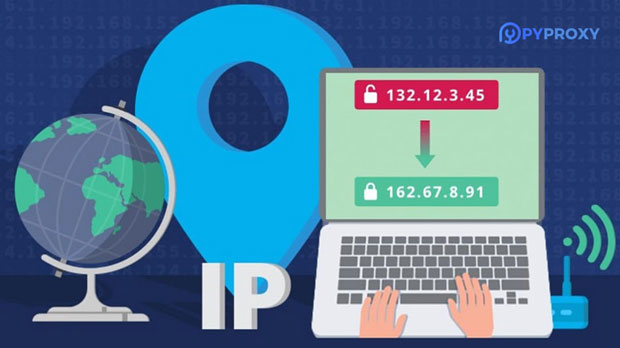When it comes to proxies, two primary categories that stand out are residential IPs and data center IPs. These two types of IPs are often used in various scenarios, such as web scraping, accessing geo-restricted content, or ensuring anonymity online. Understanding the fundamental differences between residential IPs and data center IPs can provide valuable insights for businesses or individuals who rely on proxies for their online activities. Residential IPs are issued by Internet Service Providers (ISPs) and appear as regular consumer IP addresses, making them less likely to be blocked. In contrast, data center IPs are assigned by data centers and tend to be flagged by websites due to their large-scale nature and association with non-residential services. Residential IPs vs. Data Center IPs: Key DifferencesUnderstanding the key differences between residential IPs and data center IPs can help users make more informed decisions when selecting a proxy service. These differences are crucial because they impact how proxies are treated by websites and how they perform in real-world applications.1. Source and Origin of the IPsResidential IPs are assigned by Internet Service Providers (ISPs) to actual residential users. These IP addresses come from homes or mobile networks, making them appear as legitimate, consumer-level connections. Websites view these IPs as coming from genuine users, which makes them less likely to be flagged or blocked.Data center IPs, on the other hand, are issued by data centers that house servers and network equipment. These IP addresses come from a centralized location, usually with high bandwidth and server farms. Websites can easily detect these IPs as coming from a data center and may flag them as suspicious or associate them with bot activities, as they are not typical residential IPs.2. Anonymity and TrustworthinessResidential IPs are often perceived as more trustworthy than data center IPs. Since these IPs originate from residential networks, they are less likely to be associated with automated traffic or malicious activities. As a result, they are more commonly used for tasks that require a high level of anonymity, such as web scraping, accessing geo-restricted content, and conducting market research without being detected.Data center IPs are generally viewed as less trustworthy because they are more commonly associated with bots, proxies, and automated scripts. Websites may block or limit access from data center IPs, especially if they detect high volumes of traffic from the same IP address. While data center IPs can still be effective for some tasks, they are not as reliable for activities that require a high level of trustworthiness.3. Cost and AvailabilityResidential IPs are typically more expensive and harder to obtain than data center IPs. This is due to their limited availability, as they are tied to real-world users and cannot be easily scaled in large quantities. To acquire residential IPs, proxy providers often need to work with large networks of individuals who allow their IP addresses to be used for proxy purposes.Data center IPs are much more affordable and widely available. Since they are issued by data centers, proxy providers can quickly acquire large pools of data center IPs at a low cost. This makes data center IPs a popular choice for businesses or individuals who need proxies for high-volume, low-cost tasks, such as SEO analysis, data collection, or automation.4. Performance and SpeedWhen it comes to speed and performance, data center IPs typically have the edge. Data centers are equipped with high-performance servers and infrastructure, which ensures that data center IPs can handle large volumes of traffic with minimal latency. This makes them ideal for tasks that require speed and efficiency, such as online gaming, content delivery, or high-frequency trading.Residential IPs, while more reliable in terms of trustworthiness, can sometimes experience slower speeds due to the limitations of residential internet connections. These connections are typically not as fast or stable as data center infrastructure, which can result in slower performance for activities that require high-speed internet.Advantages and Disadvantages of Residential IPsAdvantages:1. Higher Trust and Reliability: Residential IPs are less likely to be flagged or blocked by websites due to their origin from real user connections.2. Better for Anonymity: These IPs are ideal for activities that require anonymity, such as accessing content restricted by region or conducting anonymous research.3. Reduced Detection Risks: Since residential IPs appear as if they come from regular users, they are less likely to raise suspicion or trigger anti-bot measures.Disadvantages:1. Costly: Residential IPs tend to be more expensive than data center IPs due to their limited availability and the difficulty in scaling.2. Slower Speeds: Residential networks typically offer slower internet speeds, which can impact the performance of activities that require high bandwidth.3. Limited Availability: It can be difficult to acquire large quantities of residential IPs, which may limit their use for large-scale operations.Advantages and Disadvantages of Data Center IPsAdvantages:1. Cost-Effective: Data center IPs are significantly cheaper than residential IPs, making them an attractive option for businesses or individuals on a budget.2. High Availability: Since data center IPs are widely available, they can be acquired in large quantities, making them ideal for tasks that require scaling.3. Fast Performance: Data centers offer fast, high-performance connections that are ideal for high-volume tasks and operations that require speed.Disadvantages:1. Risk of Detection: Websites are more likely to detect and block data center IPs because they are often associated with automated activities, bots, or proxies.2. Less Anonymity: Data center IPs are not as anonymous as residential IPs, which can make them unsuitable for activities that require a high level of privacy or anonymity.3. Potential for Blocking: Due to their association with bots and non-residential services, data center IPs are often blacklisted or flagged by websites, limiting their usability.When to Use Residential IPs and Data Center IPsWhen to Use Residential IPs:1. Web Scraping: If you need to scrape data from websites without triggering anti-bot measures, residential IPs are your best option.2. Geo-Targeted Content Access: If you're trying to access content that is restricted to certain regions, residential IPs can help you bypass these geo-restrictions.3. Market Research: When conducting market research or competitive analysis, residential IPs provide the anonymity and trustworthiness needed to avoid detection.When to Use Data Center IPs:1. High-Volume Tasks: If you're dealing with high volumes of data, such as automated tasks, SEO analysis, or content aggregation, data center IPs are cost-effective and scalable.2. Speed-Dependent Activities: For tasks that require speed, such as online gaming or high-frequency trading, data center IPs offer the performance you need.3. Large-Scale Automation: If you're running automated scripts or bots, data center IPs can provide the scalability needed for large-scale operations.Conclusion: Making the Right ChoiceIn summary, the choice between residential IPs and data center IPs depends on the specific needs of the user. Residential IPs offer better anonymity, higher trust, and are ideal for tasks requiring a high level of privacy, though they come at a higher cost and slower speeds. Data center IPs, on the other hand, provide faster performance, scalability, and cost-effectiveness but may be flagged or blocked by websites due to their association with automated traffic.By understanding the differences and advantages of each type of IP, users can select the most suitable option for their needs, whether for web scraping, content access, or high-volume automation.
Oct 28, 2025


































































